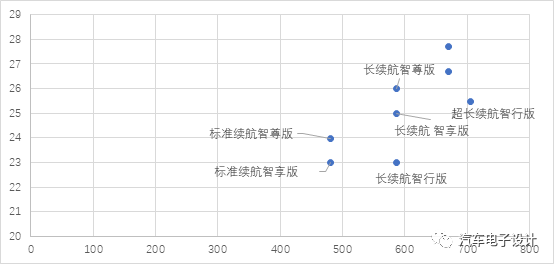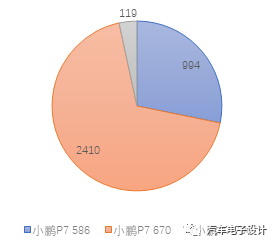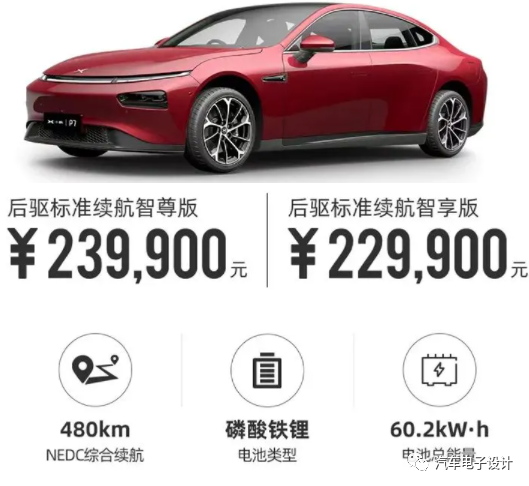Introduction
XPeng Motors, like Tesla, uses lithium iron phosphate batteries in the standard range version, as shown in the configuration table below. There are two versions of the XPeng P7 rear-wheel drive standard range model, the Smart Edition and the Premium Edition, both of which use lithium iron phosphate batteries and have a comprehensive range of 480 km.

Current Sales Situation
First, let’s look at a set of data on the delivery status of XPeng P7 at the retail level in January 2021. In January, XPeng P7 sold 3,523 units of the rear-wheel drive version and 58 units of the all-wheel drive version. Among them, 70.6% of consumers (2,529) chose the ultra-long-range version of over 670 km (but it should be noted that only 119 people bought the low configuration). 994 people chose the long-range version, accounting for 27% of the actual ratio. From this, we can see several characteristics of XPeng P7:
1) XPeng P7 is positioned around its self-driving XP2.5 and XP3, as well as its subsequent self-driving systems, without considering the needs of intelligentization. The number of consumers who buy the Smart Edition is very small.
2) In the initial stage, consumers mostly chose the longer-range version, and among the long-range and ultra-long-range versions, 70%+ of consumers made a choice.

Therefore, through this configuration table, we can see what is the purpose of XPeng introducing the lithium iron phosphate version? I think there are several main reasons:
1) XPeng, as a company focusing on intelligentization, needs to reduce the price of intelligent vehicles to within 250,000 RMB, similar to the standard version of Tesla Model 3. In comparison with the standard version of Model 3, after adding intelligent content, the range of XPeng P7 with lithium iron phosphate is higher than that of Model 3, highlighting the intelligent cabin and self-driving functions, which is more valuable than Tesla’s FSD mode.Tesla is currently mainly divided into two categories: the Enhanced Autopilot (EAP) package and the Full Self-Driving (FSD) package. The EAP package is a optional upgrade priced at ¥32,000, which enables all currently open autonomous driving features in China, including lane keeping, adaptive cruise control, all active safety configurations, automatic assisted navigation driving (NOA), automatic lane change, automatic parking, and intelligent summoning. The FSD package, priced at ¥64,000, is still under development and will be adapted to the road conditions in China. The price difference here highlights the value of lithium iron phosphate for lithium iron phosphate in achieving a more intelligent experience.
Regarding the range configuration, the standard version with a range of 480 kilometers has an impact on the 27% of customers who currently have long-range endurance. The price reduction of ¥20,000 for missing 100 kilometers of range is an extra choice for consumers. 70% of customers who prefer ultra-long-range endurance are not affected much, as there is a price difference of ¥40,000.
Considerations for range configuration:
Currently, I would like to discuss my considerations for using the long-range version with a range of 586 kilometers. During the Spring Festival, my friend and I drove several times on high-speed roads from Xuhui to Qingpu suburbs to test the actual performance of the car under typical high-speed conditions, and then we did some testing around Qingpu at low speeds. The overall performance is as follows: The actual energy consumption per 100 kilometers is approximately 15.1-15.6 kWh, which translates to a real range of 453-468 kilometers for the 586 kilometer NEDC rated range in exterior environments with temperatures around 5-10°C. As long as it is not constantly driven at 120km/h on the highway (based on an estimated reduction of approximately 70%, further reducing about 12% from the previous estimation), the actual effective range of 450 kilometers can be guaranteed.If calculated by this algorithm, 60.2kwh of lithium iron phosphate at normal temperature leads to a range of 385-400 km under the condition of 15kwh per 100 km energy consumption, which is not much different from the long-range version, with a price difference of 20,000 yuan. This allows a considerable number of young consumers who care about price and want to try autonomous driving to try. According to the current price baseline, the price difference between lithium iron phosphate and ternary is not significant (0.15 yuan /wh), which means a cost difference of 18,800 yuan, which is accurately reflected on the price. The advantage of the lithium iron phosphate version is mainly the better safety, which remains unchanged in the size and overall design of the XPeng P7.
The problem with lithium iron phosphate is mainly in winter. From the sales of XPeng P7, it is mainly concentrated in the southern provinces, including Guangdong, Shanghai, Zhejiang, Jiangsu, Sichuan, Chongqing, etc. Except for Beijing, where the quantity is relatively concentrated, the benefits of lithium iron phosphate are more for the northern provinces currently.
I think XPeng’s positioning is based on learning from Tesla in China. Among the three new car manufacturers that went to the United States, NIO’s logo is service and high positioning; Ideal is to make extended-range and worry-free cars for young parents of two children, and XPeng is making the most intelligent electric vehicles most like Tesla. Therefore, from 480km, 586km, and 670km, XPeng’s iron phosphate version also benchmarks Tesla and provides opportunities for suitable young people to get on the car in warm climates in the south.
Compared with FSD, on January 26th, the P7 OTA upgrade opened NGP automatic navigation assistance driving (public beta version) to users. Within a short period of 25 days, NGP exceeded one million kilometers. Based on NGP, the vehicle can realize automatic navigation assistance driving from point A to point B based on the navigation route set by the user. Compared with the current situation of Tesla’s users choosing to buy FSD, NGP combined with the standard mileage version is more practical and valuable for urban young consumers. The range is selected based on actual usage. The most important thing about this version is to ensure benign operation of the vehicle while expanding the XP3.0 and NGP software packages to more consumers.
ConclusionThe urban version with a range of 480 kilometers is aimed at reducing the threshold for city use. This configuration is very similar to Tesla, which quickly reduced costs and car prices while maintaining the features of the previous ternary. The 60.2kWh lithium iron battery in this case can actually support the available part of the 480 km range.
This article is a translation by ChatGPT of a Chinese report from 42HOW. If you have any questions about it, please email bd@42how.com.
